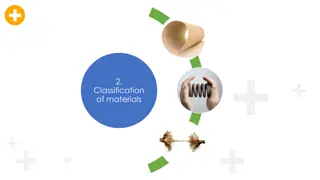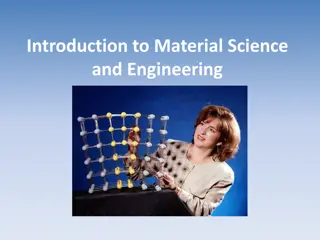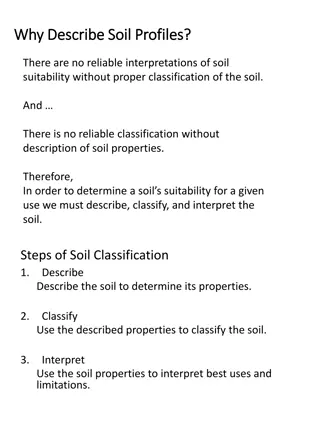Understanding Material Classification and Properties in Science
Explore the importance of grouping materials based on their properties, such as appearance, hardness, solubility, density, and transparency. Discover how materials are classified and grouped, benefitting us in organization, efficiency, and study. Learn about the significance of material characteristics like lustre and hardness, and how they influence the objects around us.
Download Presentation

Please find below an Image/Link to download the presentation.
The content on the website is provided AS IS for your information and personal use only. It may not be sold, licensed, or shared on other websites without obtaining consent from the author. Download presentation by click this link. If you encounter any issues during the download, it is possible that the publisher has removed the file from their server.
E N D
Presentation Transcript
SORTING OF MATERIALS INTO GROUPS CLASS 6 SCIENCE
Materials. Materials Around Us When we look around, we find ourselves surrounded by a number of objects. Some of these different objects are made from a number of different materials, while others are made using the same material. For Example: Both desk and chair are made from wood while pen and dustbins are made using plastic. The material from which an object is made depends on its properties.
Why do we need to group the objects We need to group objects for a number of reasons: 1. To save time to find the object. 2. It saves our energy 3. Grouping or sorting makes the place well arranged and beautiful 4. Convenience to store: We often group objects in order to store similar objects together in order to make locating them easier in the future. 5. Convenience to study: We also group objects so that it becomes easy for us to study their features as well as the patterns.
Material Grouping Material: - The matter from which an object is made is called material. E.g. glass, steel, wood, leather etc. Classification:- The process of sorting and grouping materials according to some basic similarity is called classification. Object can be classified on different basis. i.e. shape, material used, usesetc. Basis of grouping:- Material can be grouped on the basis of similarity and differences in their property. Different types of material have different properties such as appearance, solubility, transparency, conductivityand behavior towards magnet etc. www.reflectivelearn.com
Properties of materials We choose to make an object depending on its properties and the purpose for which the object is to be used. So we should know some properties of materials: 1. Appearance 2. Hardness 3. Solubility 4. Density 5. Transparency
Appearance Materials can be classified on the basis of how they look or appear. Some materials have lustre, which is a soft glow to them while others are plain ordull . Materials that have such lustre can usually be classified as Metals. Examples include gold, copper, aluminium, iron etc. Usually, a metal loses its lustre after some time due to the action of moisture and air on it. This is called Corrosion of metals. Therefore only freshly-cut metals appear to have lustre on them. Lustre of Gold
Hardness Materials can also be classified on the basis of hardness. Materials that can be easily compressed or scratched are called Soft. Ex-cotton, sponge Materials that cannot be scratched and are difficult to compress are termed as Hard. Ex- iron, wood
Metal Iron is Hard Hardness
Soluble and Insoluble Soluble and Insoluble materials Materials that can be dissolved in water upon stirring are said to be soluble materials. For Example, Sugar and Salt can be dissolved in water. Materials that cannot be dissolved in water no matter how much we stir them are said to be insoluble materials. For Example, Stones and Clothes cannot be dissolved in water. Not just solid materials, even liquids have the property of being soluble or insoluble. For Example, Lemon juice can easily dissolve in water while oil does not dissolve and deposits as a thin layer on the uppermost layer of water.
Objects that can Sink and Float DENSITY There are some insoluble materials which sink to the bottom of the surface when put in water while some other floats on water. It is all because of Density of a substance. Density is defined as mass present in per unit of volume of the substance. Understand the Concept Object with higher density than water will sink. A coin is made up of metal. Density of metal is higher than water. That s why coin sinks in water. The objects with lesser density than water will float on water. For Ex: Leaves and Corks float on water while rocks and coins sink in water
Objects that can Sink and Float Tell the Answer:- The objects can Sink and Float depending on their density relative to water. Answer the following: Will a needle float or sink? Will a plastic pen float or sink in water? Will a pencil float or sink in water?
Transparency Understand the Concept Objects or materials which can be seen through are said to be transparent objects. For Example, Glass, clear water and some plastics can be seen through and are hence transparent materials. Objects and materials through which things can be seen but only partially are called Translucent objects. For Example Butter paper and frosted glass are some examples of translucent objects. Objects which cannot be seen through are known as opaque objects. For Example, Metals, wood and cardboard are some examples of opaque materials as you cannot see through them.
Transparency Understand the Concept Objects or materials are transparent because the light rays can easily pass through them. Glass, clear water and some plastics can be seen through because light can easily pass through them. Objects or materials are translucent because the light rays partially pass through them. Butter paper and frosted glass allow the light to partially pass through them. Objects or materials are opaque because the light rays cannot pass through them. Metals, wood and cardboard are some examples of opaque objects. No light can pass through them so you cannot see through them.
Thank You THANK YOU























